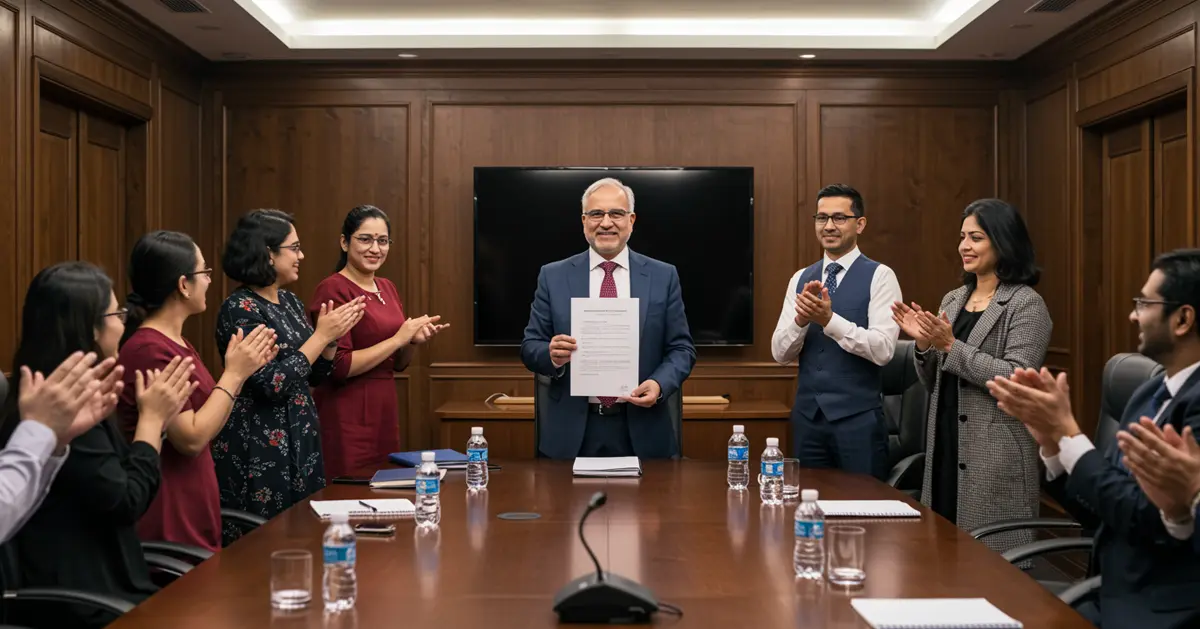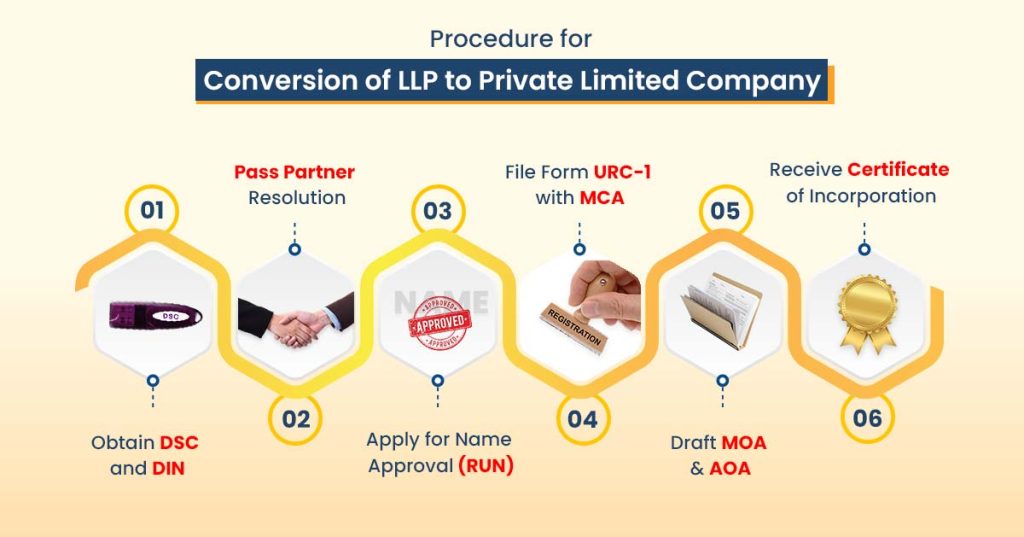
How to Convert LLP to Private Limited Company in India
A Limited Liability Partnership (LLP) is a business structure that combines elements of a partnership and a company, offering flexibility with limited liability. As an LLP grows, it may face restrictions in fundraising, ownership structuring, or scalability. In such cases, many promoters prefer the conversion of LLP to Private Limited Company to access wider funding options and a more recognized corporate framework.
A Private Limited Company incorporation offers improved investor acceptance, clearer shareholding structures, and stronger corporate governance under the Companies Act, 2013. For businesses planning long-term expansion, the conversion of LLP to private limited company can be a strategic shift.
This blog provides a comprehensive guide on how to convert an LLP into a Private Limited Company in India, along with legal requirements, tax implications, and common challenges.
Why Convert LLP to Private Limited Company?
Converting a Limited Liability Partnership(LLP) into a Private Limited Company is a strategic decision that many growing businesses make to achieve greater flexibility, access to funding, and operational efficiency.
Here are some benefits of a private limited company that support the idea of conversion:
1. Access to Funding and Investment Opportunities
LLPs cannot issue shares to raise capital, making it difficult to attract investors. Private Limited Companies can issue shares, attract venture capital, and raise funds from angel investors or private equity firms.
2. Separate Legal Entity with Corporate Identity
A Private Limited Company enjoys a separate legal identity, meaning it can own assets, enter into contracts, and sue or be sued in its name. This provides greater credibility in the market.
3. Limited Liability Protection for Shareholders
Both LLPs and Private Limited Companies offer limited liability protection, but a Private Limited Company provides better legal security for shareholders.
4. Increased Business Growth and Expansion
India and international markets widely recognize a Private Limited Company, which makes it easier for you to expand operations, secure partnerships, and build credibility with customers and suppliers.
5. Compliance and Governance Structure
While an LLP has fewer compliance requirements, a Private Limited Company provides a well-defined corporate governance structure under the Companies Act, 2013.
Eligibility Requirements for Conversion of LLP to Private Limited Company
Before converting an LLP into a Private Limited Company, ensure your business meets the eligibility criteria under Section 366 of the Companies Act, 2013. These requirements ensure regulatory compliance and prevent complications during the transition. The conversion can only be initiated when the LLP fulfils the conditions below:
1. Approval from LLP Partners
The first and most crucial step in converting an LLP (Limited Liability Partnership) into a Private Limited Company is obtaining approval from all partners.
- The conversion process requires unanimous consent from all partners of the LLP.
- The partners must pass a formal resolution in a meeting to approve the conversion.
- Clearly state the intention to convert the LLP into a Private Limited Company in the resolution and duly document it.
2. Minimum Shareholders and Directors
To ensure smooth governance and legal compliance, the Companies Act, 2013 mandates specific minimum requirements for the number of shareholders and directors in a Private Limited Company.
- A Private Limited Company must have at least two shareholders and two directors.
- At least one director must be a resident of India, meaning they must have stayed in India for at least 182 days in the preceding financial year.
- The partners of the LLP can become shareholders and directors in the newly converted Private Limited Company.
3. LLP Must Be Registered Under the LLP Act, 2008
You must register your LLP under the LLP Act, 2008, before converting it into a Private Limited Company. If the LLP is not incorporated, conversion is not allowed.
- Only legally registered LLPs under the Limited Liability Partnership Act, 2008, are eligible for conversion.
- Unregistered partnerships or informal business structures do not qualify for direct conversion and must first register as an LLP before applying for conversion.
4. No Existing Legal Liabilities or Pending Cases
Before converting an LLP into a Private Limited Company, it is essential to ensure that the business is free from any legal disputes, pending cases, or outstanding liabilities.
- The LLP should not have any outstanding legal disputes, lawsuits, or pending cases in any court.
- You must resolve or transfer any ongoing litigation before converting the LLP.
- You must clear any unpaid statutory dues or penalties with regulatory authorities, such as the Ministry of Corporate Affairs, Income Tax Department, or GST authorities.
Documents Required for Conversion of LLP to Private Limited Company
Before knowing about how to convert LLP to private limited company, it’s crucial to submit all the essential documents to the Registrar of Companies (ROC). These documents ensure that the conversion complies with regulatory requirements and facilitates smooth processing.
Below is a list of documents required for the conversion process:
1. LLP Incorporation Certificate
This document verifies the legal existence of the LLP. You must submit the company incorporation certificate as proof that your business is registered under the Limited Liability Partnership Act, 2008.
2. LLP Agreement
The original LLP agreement must be provided. This agreement outlines the internal structure and operational framework of the LLP.
3. Consent of All LLP Partners
All partners must provide written consent, confirming their approval of the conversion. The LLP partners typically document this through a passed resolution.
4. Financial Statements
The LLP must submit its most recent balance sheet and profit & loss statement for verification. These documents demonstrate the financial health and compliance of the LLP.
5. Identity and Address Proof of Directors and Shareholders
You must provide identification documents such as a PAN card, an Aadhaar card, a passport, or a voter ID (for Indian citizens) and a passport (for foreign nationals). You also need to submit address proofs like utility bills or bank statements.
6. Registered Office Proof
Proof of the registered office address is necessary. This can include a rent agreement (if rented), electricity bill, or NOC from the landlord. A Virtual office would also work as long as it’s legally registered.
7. Digital Signature Certificate (DSC)
The proposed directors must obtain a Digital Signature Certificate (DSC) to sign electronic documents and forms during the conversion process.
8. Director Identification Number (DIN)
All directors of the newly formed Private Limited Company must obtain a Director Identification Number (DIN). If the directors don’t already have a DIN, they will need to apply for one through the MCA portal.
Step-by-Step Process to Convert LLP to Private Limited Company
The procedure for conversion of LLP to a Private Limited Company follows a structured sequence regulated by the Ministry of Corporate Affairs. Completing these steps correctly ensures faster approval and a smooth legal transition.
Here’s a simplified version of the step-by-step process:

1. Obtain a DSC and DIN
The first step is to obtain a Digital Signature Certificate (DSC) and Director Identification Number (DIN), which are crucial aspects for the process of conversion.
- All proposed directors must apply for a Digital Signature Certificate (DSC) for signing electronic documents.
- Additionally, every director must have a Director Identification Number (DIN), which is required for legal identification under the Companies Act, 2013.
2. Pass a Resolution for Conversion
For converting the LLP into a Private Limited Company, the partners of the LLP should pass a resolution by giving their consent to the process of conversion.
- The partners of the LLP must hold a meeting and pass a formal resolution agreeing to convert the LLP into a Private Limited Company.
- The resolution must be recorded and signed by all partners, indicating their consent.
3. Name Approval from the Ministry of Corporate Affairs (MCA)
For converting to a Private Limited Company, the LLP must give a unique name to the Private Limited Company.
- The new Private Limited Company must have a unique name.
- Apply for company name approval through the RUN (Reserve Unique Name) service on the MCA portal.
- Ensure the name complies with MCA naming guidelines and is available for registration.
4. File Form URC-1 with MCA
After obtaining name approval and passing the resolution for conversion, the next crucial step is to file Form URC-1 with the Ministry of Corporate Affairs (MCA).
- Form URC-1 must be filed with the Registrar of Companies (ROC).
- Attach the required documents, including the LLP agreement, partners’ consent, financial statements, and proof of registered office.
5. Draft and Submit MOA and AOA
Memorandum and Articles of Association are the most important documents, and they should be drafted, signed by the directors, and submitted to the ROC.
- The Memorandum of Association (MOA) outlines the company’s objectives, and the Articles of Association (AOA) define the internal governance rules.
- Both documents must be signed by all directors and submitted to the ROC.
6. Certificate of Incorporation
Once the Registrar of Companies (ROC) verifies all the documents you submit, you can complete the conversion process by obtaining the Certificate of Incorporation. This certificate officially confirms the conversion of the LLP into a Private Limited Company.
Legal and Tax Implications of LLP Conversion
The conversion of LLP to Private Limited Company results in important legal and taxation changes. A Private Limited Company must operate under stricter compliance norms, corporate governance rules, and reporting requirements compared to an LLP.
Post-conversion, the business will fall under the Companies Act, 2013, and must follow structured management and disclosure standards.
Here are the legal and tax implications for conversion:
1. Legal Compliance under the Companies Act, 2013
Companies Act, 2013, imposes stricter regulatory compliance requirements than those for LLPs, which include corporate governance norms, filing obligations, and operational procedures.
This means that the company will need to comply with:
- Annual General Meetings (AGM): Private limited companies are required to hold AGMs every year.
- Board Meetings: The company must conduct regular board meetings and record minutes.
- Corporate Governance: Private Limited Companies must follow strict governance norms, including the appointment of directors, maintenance of statutory registers, and filings with the Registrar of Companies (ROC).
2. Taxation Structure
The tax structure for an LLP differs significantly from that of a Private Limited Company. After conversion, the company pays tax under corporate tax laws, which offer distinct benefits and obligations.
Below are key tax-related implications:
- LLP Taxation: The government taxes LLPs at 30%, and it taxes each partner’s income separately based on personal income tax slabs.
- Private Limited Company Taxation: Unlike LLPs, where the partners pay tax on their income, a Private Limited Company functions as a separate legal entity and pays tax at corporate tax rates.
3. Legal Documentation and Filing Requirements
Post-conversion, the new Private Limited Company will have to follow specific filing and documentation requirements mandated by the Registrar of Companies (ROC).
- Filing with ROC: Post-conversion, the Private Limited Company will have to file certain documents with the Registrar of Companies (ROC), including Annual Returns and Financial Statements.
- Contractual Obligations: Review all contracts and agreements signed by the LLP, such as leases, employee contracts, and vendor agreements, and amend them as needed to reflect the name of the new Private Limited Company.
Common Challenges in LLP to Private Limited Company Conversion
While converting an LLP to a Private Limited Company can offer several advantages, the process is not without its challenges. Entrepreneurs and business owners may face a range of difficulties during the conversion, from legal complications to financial implications.
Key challenges during the conversion include:
1. Legal and Documentation Complexities
One of the most common challenges in converting an LLP to a Private Limited Company is the complexity of legal procedures and documentation.
The process involves multiple filings with the Registrar of Companies (ROC), including the submission of Form URC-1, Memorandum of Association (MOA), Articles of Association (AOA), and other supporting documents.
2. Valuation of Assets and Liabilities
When converting an LLP to a Private Limited Company, there can be challenges related to the valuation of assets and liabilities.
Value all LLP assets, including fixed assets, intellectual property, and other business assets, accurately so they reflect their fair market value in the new company structure.
3. Tax Implications and Liabilities
The shift from an LLP to a Private Limited Company can lead to unforeseen tax implications and liabilities.
Additionally, the transition to a corporate tax regime introduces different taxation rates, such as Dividend Distribution Tax (DDT), Minimum Alternate Tax (MAT), and other corporate taxes.
4. Change in Governance and Management Structure
A Private Limited Company operates under a more formal governance structure compared to an LLP and requires several changes for the conversion.
Converting the business to a Private Limited Company may require changes in management roles, responsibilities, and decision-making processes. This can disrupt operations, especially if you don’t plan the transition carefully.
LLP vs Private Limited Company: Key Difference Explained
When starting or growing a business, choosing the right legal structure is crucial for long-term success. Limited Liability Partnership (LLP) and Private Limited Company are two popular business structures in India, each offering distinct advantages and disadvantages.
Here is the difference between LLP and Private Limited Company :
| Feature | LLP | Private Limited Company |
| Legal Structure | A hybrid of partnership & Company | Separate legal entity |
| Ownership | Partners | Shareholders & Directors |
| Liability Protection | Limited to partners’ contributions | Limited to shareholders’ shares |
| Fundraising Options | Cannot issue shares | Can raise funds via equity |
| Taxation | LLP tax rates apply | Corporate tax rates apply |
| Regulatory Compliance | Governed by the LLP Act, 2008 | Governed by the Companies Act, 2013 |
| Annual Compliance | Less stringent | Requires more statutory compliance |
Ending Note
Converting an LLP into a Private Limited Company provides several benefits, including better funding opportunities, a corporate structure, and limited liability protection. However, the process involves multiple legal, tax, and compliance steps. Ensuring proper documentation and following the prescribed steps can help businesses transition smoothly.
Contact RegisterKaro to consult with legal and financial experts who can help you navigate the conversion process, evaluate your business needs, and guide you in making the right decision for your future success.
Frequently Asked Questions (FAQs)
1. Can an LLP be converted into a Private Limited Company?
An LLP can be converted into a Private Limited Company under Section 366 of the Companies Act, 2013, subject to meeting eligibility rules and following the prescribed procedure for conversion of LLP to Private Limited Company, including documentation, partner approval, and MCA filing.
2. How long does the conversion of LLP to Private Limited Company take?
The conversion timeline is typically 30 to 45 days, depending on MCA approval speed, completeness of documents, availability of a unique name, and verification by the Registrar of Companies. Timelines may vary if legal or financial clarifications are required during processing.
3. Do business owners need to close the LLP before conversion begins?
The LLP does not need to be dissolved before conversion. The structure continues during the process, and after approval, the entity becomes a Private Limited Company under the Companies Act while retaining continuity of business operations and contracts.
4. What happens to assets and liabilities after the LLP is converted?
All assets, liabilities, agreements, and existing obligations automatically transfer to the new Private Limited Company. No separate transfer documentation is required, and the conversion has no impact on ownership of property, ongoing contracts, employment terms, or vendor agreements.
5. Can a Private Limited Company be converted back into an LLP later?
A Private Limited Company may apply to convert back into an LLP in accordance with the LLP Act, 2008. The process requires ROC approval, partner consent, and submission of supporting documents to confirm the new legal structure and continuity of business.




